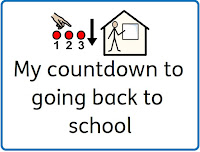Post #31 Thoughts about School and Next Steps
As some children return to school, many of us are thinking about the next steps for our children. This is yet another anxious time, with important decisions to make. So, what do we need to think about and how can we prepare our children for their next steps, whether it is returning to school or continuing with home learning?
Be PreparedThe easing of lockdown generates mixed emotions. For some, anticipation of seeing loved ones for the first time in a while, or being able to meet up with friends, is exciting. These changes are also generating anxiety, with fears of whether the virus will spread and cause a second peak. Just as staying at home and not going to school was a big change in our children's lives, so is the return to school or college. Whether your child is returning to school now or later, preparation is the key to managing the transition and supporting their wellbeing. It is worth starting the preparation process now, even if you do not know when your son or daughter will return to school/college.
Resources
There are some excellent resources available to help you to plan for your child's return to school or college. Dumond Education have developed The BUILD Process for reducing anxiety around school return. Here is what they say:
Our BUILD Process provides 5 interlinked areas we feel are essential as we begin to think about the changes we face and establishing a ‘new normal.’ It has been designed to stimulate conversation and thinking – hopefully acting as a catalyst for effective educational transformation and regeneration.
BUILD identifies the following interlinked areas: Belonging, Understanding, Intention, Learning, Dynamics. You can download the BUILD document here: The BUILD Process The website also includes links to 10 excellent resources to reduce anxiety around returning to school.
PHOENIX Learning and Care Speech and Language Therapy Team have produced a booklet: Supporting Transition Back into the Learning Environment - Ways to support understanding and reduce anxiety. This includes useful resources including visual supports with symbols, for example a countdown to going back to school:
It's worth checking out the resources, which include support for children & young people to communicate about their lockdown experiences. Find the resources here: PHOENIX resources school return or PHOENIX resources college return
Lynn McCann of ReachoutASC, together with schudiotv, has produced an online course: The Big Transitions for Autistic and SEND Pupils after Lockdown which includes lots of useful content including starting in a new class, school or college. See: The Big Transitions after Lockdown. The course lasts around 1 hour, broken down into 5 mins chunks. There are some great reviews of this course on twitter so do consider enrolling (currently free).
Dr Siobhan Timmins has provided some free Social Stories to help prepare for school return: Return to school - Social Stories
Visual structure is essential, whether your child is back at school or continuing to learn at home. There have been suggestions for blended learning or flexible learning for some children and young people, whereby learning takes place both at school/college and at home. This arrangement might suit many of our children and I know some parents have called for this before we entered the current crisis. I know I go on about these but clear visual timetables or schedules are essential, whatever the arrangement is for your child to continue their learning. The changes to routines which I wrote about in early posts are likely to continue for some time into the future, so making sure we provide meaningful visual information for our children remains a high priority. Visual timetables or schedules provide support and reduce anxiety about what is happening and are important during yet another transition. A split visual timetable can show where and when learning will take place and includes subjects and topic lessons at school/college and at home. Take a look at this great example: Visual timetable blended learning
Discuss with teachers or SENCOs the arrangements for your son or daughter to return to school/college and the best way to provide a visual timetable or schedule which is consistent between home and school/college. Developing the schedule in collaboration with the setting is important and will make sure you are 'on the same page' - this helps you, and teachers, to answer your child's questions about what is happening as they arise.
Other issues: entitlement, risk assessments, EHCPs
There is much discussion and debate regarding SEND provision, with further changes which may cause you some anxiety. In particular there are concerns about entitlement, risk assessments and EHCPs. If you are someone who likes to be armed with knowledge and likes to look at the details, take a look at very useful information provided by IPSEA:
Independent Provider of Special Education Advice (IPSEA) offers free and independent legally based information, advice and support to help get the right education for children and young people with all kinds of special educational needs and disabilities (SEND).
Our unique range of services has been developed to ensure that families understand their children’s legal rights and entitlements and that they are empowered to enforce those rights to secure the right education for their child.
In particular, see the IPSEA update on COVID-19, school closures and SEN provision which provides useful FAQ: IPSEA. You may have concerns regarding risk assessments and/or your son's or daughter's EHCP and their rights and entitlements at this time. IPSEA provides useful and accurate information in this regard so do take a look at their detailed information. You might also like Special Needs Jungle which provides 'parent-led information, resources and informed opinion about children and young people 0 - 25'.

Comments
Post a Comment